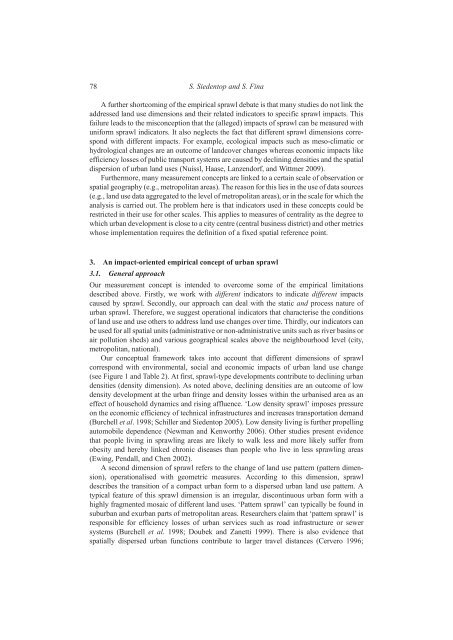PDF 20.134kB - TOBIAS-lib - Universität Tübingen
PDF 20.134kB - TOBIAS-lib - Universität Tübingen
PDF 20.134kB - TOBIAS-lib - Universität Tübingen
Erfolgreiche ePaper selbst erstellen
Machen Sie aus Ihren PDF Publikationen ein blätterbares Flipbook mit unserer einzigartigen Google optimierten e-Paper Software.
78 S. Siedentop and S. Fina<br />
A further shortcoming of the empirical sprawl debate is that many studies do not link the<br />
addressed land use dimensions and their related indicators to specific sprawl impacts. This<br />
failure leads to the misconception that the (alleged) impacts of sprawl can be measured with<br />
uniform sprawl indicators. It also neglects the fact that different sprawl dimensions correspond<br />
with different impacts. For example, ecological impacts such as meso-climatic or<br />
hydrological changes are an outcome of landcover changes whereas economic impacts like<br />
efficiency losses of public transport systems are caused by declining densities and the spatial<br />
dispersion of urban land uses (Nuissl, Haase, Lanzendorf, and Wittmer 2009).<br />
Furthermore, many measurement concepts are linked to a certain scale of observation or<br />
spatial geography (e.g., metropolitan areas). The reason for this lies in the use of data sources<br />
(e.g., land use data aggregated to the level of metropolitan areas), or in the scale for which the<br />
analysis is carried out. The problem here is that indicators used in these concepts could be<br />
restricted in their use for other scales. This applies to measures of centrality as the degree to<br />
which urban development is close to a city centre (central business district) and other metrics<br />
whose implementation requires the definition of a fixed spatial reference point.<br />
3. An impact-oriented empirical concept of urban sprawl<br />
3.1. General approach<br />
Our measurement concept is intended to overcome some of the empirical limitations<br />
described above. Firstly, we work with different indicators to indicate different impacts<br />
caused by sprawl. Secondly, our approach can deal with the static and process nature of<br />
urban sprawl. Therefore, we suggest operational indicators that characterise the conditions<br />
of land use and use others to address land use changes over time. Thirdly, our indicators can<br />
be used for all spatial units (administrative or non-administrative units such as river basins or<br />
air pollution sheds) and various geographical scales above the neighbourhood level (city,<br />
metropolitan, national).<br />
Our conceptual framework takes into account that different dimensions of sprawl<br />
correspond with environmental, social and economic impacts of urban land use change<br />
(see Figure 1 and Table 2). At first, sprawl-type developments contribute to declining urban<br />
densities (density dimension). As noted above, declining densities are an outcome of low<br />
density development at the urban fringe and density losses within the urbanised area as an<br />
effect of household dynamics and rising affluence. ‘Low density sprawl’ imposes pressure<br />
on the economic efficiency of technical infrastructures and increases transportation demand<br />
(Burchell et al. 1998; Schiller and Siedentop 2005). Low density living is further propelling<br />
automobile dependence (Newman and Kenworthy 2006). Other studies present evidence<br />
that people living in sprawling areas are likely to walk less and more likely suffer from<br />
obesity and hereby linked chronic diseases than people who live in less sprawling areas<br />
(Ewing, Pendall, and Chen 2002).<br />
A second dimension of sprawl refers to the change of land use pattern (pattern dimension),<br />
operationalised with geometric measures. According to this dimension, sprawl<br />
describes the transition of a compact urban form to a dispersed urban land use pattern. A<br />
typical feature of this sprawl dimension is an irregular, discontinuous urban form with a<br />
highly fragmented mosaic of different land uses. ‘Pattern sprawl’ can typically be found in<br />
suburban and exurban parts of metropolitan areas. Researchers claim that ‘pattern sprawl’ is<br />
responsible for efficiency losses of urban services such as road infrastructure or sewer<br />
systems (Burchell et al. 1998; Doubek and Zanetti 1999). There is also evidence that<br />
spatially dispersed urban functions contribute to larger travel distances (Cervero 1996;

















